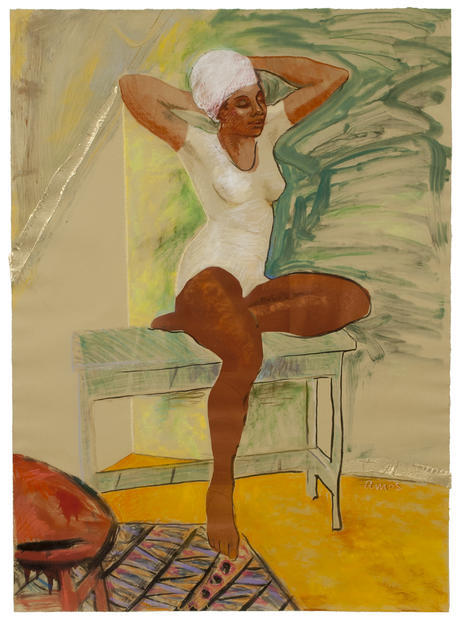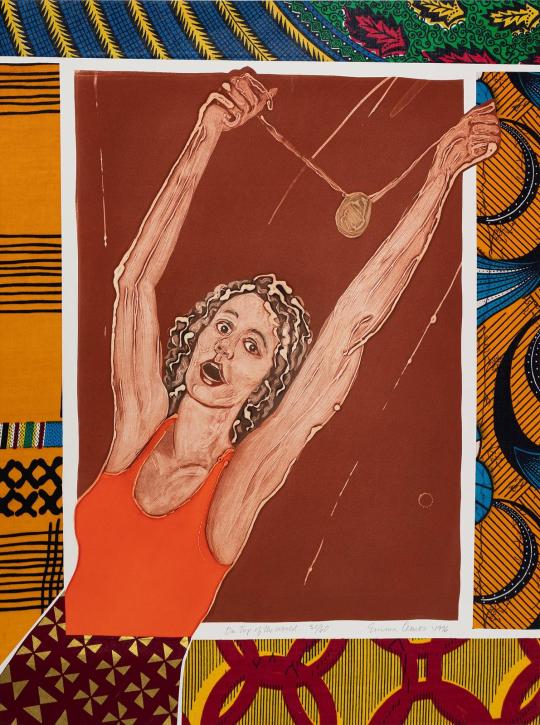#emma amos
Photo

Emma Amos, Flower Sniffer, 1966
152 notes
·
View notes
Text
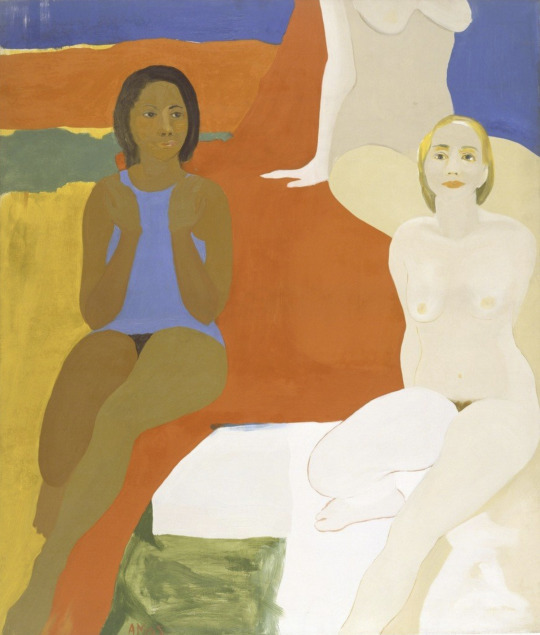
Emma Amos, Three Figures, 1966, oil on canvas, 60 x 50 in (152.4 x 127 cm)
19 notes
·
View notes
Photo

Emma Amos, Out in Front, 1982
227 notes
·
View notes
Text

Emma Amos, Thank You Jesus for Paul Robeson (and for Nicholas Murray's Photograph - 1926), 1995
11 notes
·
View notes
Photo

Look to the Sun
African fabric and acrylic on canvas
Emma Amos
92 notes
·
View notes
Text
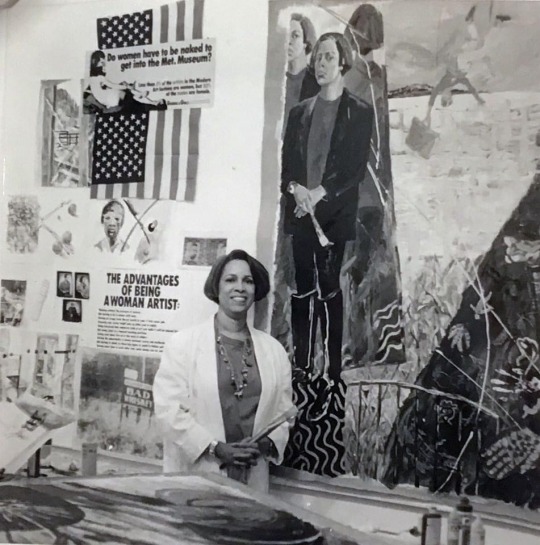
Emma Amos (16 March 1937 – 20 May 2020) was a postmodern African-American painter and printmaker.
Amos moved to New York City after feeling stunted by the slow move of the Atlanta art scene. Amos was not expecting the level of racism, sexism, and ageism that she encountered upon moving to New York.
She edited the collective's journal Heresies: A Feminist Publication on Art and Politics.
Emma Amos was also a member of the anonymous feminist group Guerilla Girls and used the pseudonym Zora Neale Hurston.
(See more / source Wikipedia)
3 notes
·
View notes
Text

Born in 1937 in Georgia, Emma Amos took an interest in art while she was a child. She made paper dolls and copied the figures from magazines.
At age eleven she took classes at Morris Brown School. She improved her draftsmanship and was exposed to the art of other Black American students.
While she was still in high school, she was already submitting her work to art shows at Atlanta University.
It was clear for the very beginning, Emma was going places.
Emma studied art at the Central School of At in London after graduatiing for Antioch College in Ohio. She would move to New York looking for a more vibrant art scene that she couldn't find in Georgia upon returning to the US.
She would be blindsided by the racism and sexism and even, ageism she was met with, perhaps assuming the more metropolitan state would be more progressive.
She was too young for galleries to bother with her and she had trouble finding positions available to teach.
She did eventually find work, as an assistant, at the Dalton School.
This did end up fortuitous as she met other artists that introduced her to the art scenes in New York and East Hampton.
She still found struggles. She was a woman in an art world that prioritized the work of men. And she was a black woman, and like many black artists, struggled to find dealers and curators that wanted to work with her.
Emma would not be deterred.
She joined Letterio Calapai's print making studios and Robert Blackburn's Printmaking Workshop. She earned her Masters of Art from New York University in 1966 and became reacquainted with artist Hale Aspacio Woodruff who was teaching there.
She met with Woodruff for feedback and criticism of her work and he introduced her to Spiral Arts Alliance. A collective of African-American Artists. Not just art, this group discussed philosophy, and culture about the meaning of blackness within the African diaspora. A frame work for critique and cultivating "Black Consciousness" and a common racial identity.
She would be allowed to join, as the first female member of the group.
At this time, she was working full time as a designer and studying full time as well. It left her only time to paint on the weekends.
In 1965 Spiral rented space for the first and only Exhibition. Emma would exhibit an etching called Without a Feather Boa, that sadly, is now lost.
Described as a self portrait, a nude bust, of Emma looking dispassionately at the viewer from behind sunglasses.
Before this, Emma has been reticent to participate in the idea of Black Art and galleries and shows that only showed the work of black Americans. Like so many artists, she likely though of herself as an artist first, but came to understand the harsh reality was that there were not a lot of options for black artists. These Black Art shows and galleries were the only way to get your foot in the door.
Despite this early resistance, she embraced sex and race in her art, toeing the line of politics but never allowing her work to be drowned in controversy. There were often depictions of the confederate flag, the American flag, traditional African patterns, including her own weavings as she was a well accomplished craftsman as well as a painter.
Emma became a professor in 1980, and later chair of the Visual Arts Department at the Mason Gross School of Art at Rutgers University, and she would teach there for close to thirty years.
During her time here she would join the Heresies Collective. A feminist group founded in 1976 in New York by feminist political artists.
She says of the group:
"And that’s what Heresies became for me. All of my disdain for white feminists disappeared, because we were all in the same boat. We just came to the boat from different spaces."
She was also a member of the feminist group Guerilla Girls under the pseudonym Zora Neale Hurston.
In these groups, and others she took part in, she discussed the sex revolution of the 60s and 70's the failures of white feminism, and the privilege of white Americans in the arts and in life.
She was keenly aware of artists that existed within the margins of society and how difficult it is for those people to continue activities in comparison the white hegemonic art circles.
In 2008, Emma retired from teaching, but she never stopped being a teacher, supporting her students even after, going to their exhibitions and continuing to inspire and be inspired.
In 2020, Emma died from complications of Alzheimer's Disease. She was 83.
Her work is viewable in many, many galleries and museums and we've only just scratched the surface of this woman's art, passions, and intriguing life. If you'd like to see more of Emma's work and learn more about her:
Museum of Modern Art - Emma Amos - Works
Philadelphia Museum of Art - Emma Amos: Color Odyssey
Virtual Discussion: Emma Amos: Color Odyssey
NYT Emma Amos, Painter who challenged Racism and Sexism, Dies at 83
DVD/VHS for purchase Emma Amos - Actions Lines
Ryan Lee Gallery - Emma Amos
Emma Amos Website
#Emma Amos#Black History Month#Black Artist#Black Art History#Black Feminist Artist#Art History#Painter#Printmaker#Weaver#Artisan#Black Craftsman
13 notes
·
View notes
Text
Greatest Days. Movie Review
In this author’s mind, the original Mamma Mia movie is a strong contender for the greatest/worst thing ever created. It has enough self-awareness to have some sort of handle on the party atmosphere but nowhere near enough to realize just how effectively the final product is a bucket of camp cheese. This is perfectly encapsulated by the Lay All Your Love On Me sequence as the chorus of shirtless…

View On WordPress
#Aisling Bea#Alice Lowe#Amaka Okafor#Coky Giedroyc#Eliza Dobson#Emma Amos#Jayde Adams#Lara McDonnell#Marc Wootton#Matthew McNulty#Take That
2 notes
·
View notes
Text
Greatest Days (2023) Review
A film adaptation of the Greatest Days / The Band Musical featuring songs of Take That.
⭐️
Continue reading Untitled

View On WordPress
#2023#Aaron Bryan#Aisling Bea#Alfredo Tavares#Alice Lowe#Amaka Okafor#Barry O&039;Connor#Based on a Musical#Carragon Guest#Coky Giedroyc#Comedy#Drama#Eliza Dobson#Emma Amos#Emmet Byrne#Greatest Days#Hannah James-Scott#Jayde Adams#Jessie Mae Alonzo#Joanne James#Lara McDonnell#Leonardo Thimo#Linda John-Pierre#Marc Wootton#Matthew Koon#Matthew McNulty#Music#Musical#Nandi Hudson#Nicolas Politis
0 notes
Text

Daily Painting
Emma Amos
SANDY AND HER HUSBAND (1973)
1 note
·
View note
Text
Women in Art: Emma Amos
Women in Art: Emma Amos

View On WordPress
0 notes
Text

#florence + the machine#florence welch#choreomania#hayley williams#michelle zauner#fka twigs#muna#phoebe bridgers#julien baker#lucy dacus#mitski#tori amos#pj harvey#fiona apple#halsey#emma ruth rundle#chelsea wolfe#lingua ignota#karen o#sasami#mia morgan#lyschko#anna calvi#alvvays#alice glass#ethel cain#taylor swift#olivia rodrigo#arca#clairo
346 notes
·
View notes
Text
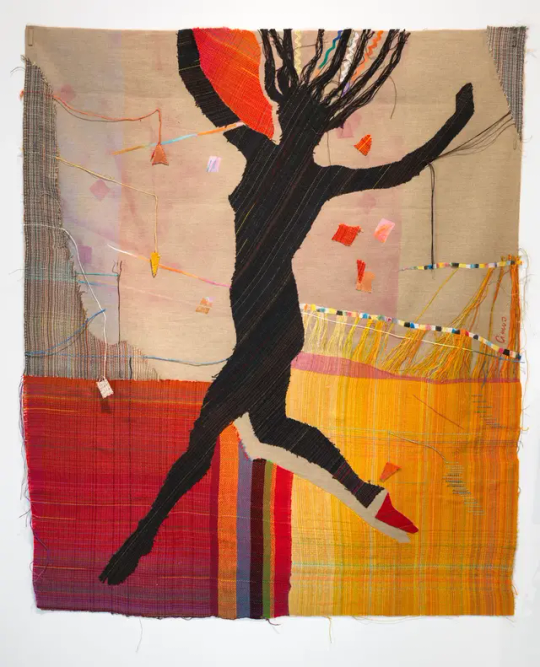
Emma Amos, Winning, 1982, acrylic on linen with hand-woven fabric, Smithsonian American Art Museum
2 notes
·
View notes
